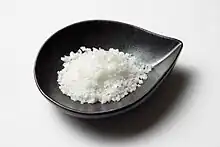
A bowl of Korean sea salt

Korean sea salt crystals
Korean brining salt, also called Korean sea salt, is a variety of edible salt with a larger grain size compared to common kitchen salt.[1][2] It is called gulgeun-sogeum (굵은소금; "coarse salt") or wang-sogeum (왕소금; "king/queen salt") in Korean.[3][4][5] The salt is used mainly for salting napa cabbages when making kimchi. Because it is minimally processed, there are microorganisms present in the salt, which serve to help develop flavours in fermented foods.[1]
References
- 1 2 Parks, Cara (16 December 2014). "Shaking Up Salt". Modern Farmer. Archived from the original on 10 January 2017. Retrieved 10 January 2017.
- ↑ Kierzek, Kristine M. (11 March 2016). "Cooking up a cultural connection with Kimchi". Milwaukee Journal Sentinel. Archived from the original on 10 January 2017. Retrieved 10 January 2017.
- ↑ "wang-sogeum" 왕소금. Korean–English Learners' Dictionary. National Institute of Korean Language. Archived from the original on 10 January 2017. Retrieved 10 January 2017.
- ↑ "wang-sogeum" 왕소금. Standard Korean Language Dictionary (in Korean). National Institute of Korean Language. Archived from the original on 10 January 2017. Retrieved 10 January 2017.
- ↑ "gulgeun-sogeum" 굵은소금. Standard Korean Language Dictionary (in Korean). National Institute of Korean Language. Archived from the original on 10 January 2017. Retrieved 10 January 2017.
This article is issued from Wikipedia. The text is licensed under Creative Commons - Attribution - Sharealike. Additional terms may apply for the media files.